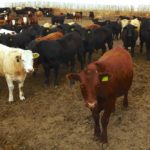Compared to last week, western Canadian yearlings and calves over 700 lbs. traded steady to $3 lower on average. Weakness in the fed cattle market weighed on the heavier replacements. Alberta packers were buying fed cattle at $155 on a live basis, down $7 from the highs seven days earlier. Barley prices were up $3-$5 […] Read more

Klassen: Fed cattle weakness pressures yearlings

Klassen: Feeder market easily absorbs adverse weather
Western Canadian feeder markets were relatively unchanged from week-ago levels but there were a couple of unique characteristics in certain regions. Quality yearling packages were $2-$4 higher in Alberta but fleshier replacements were discounted. Eastern Prairie regions had grass cattle under 600 lbs. trading $3 to as much as $8 above week-ago levels. Order buyers […] Read more

Klassen: Fed cattle market lifts feeder prices
Compared to last week, western Canadian feeder cattle markets traded $4 on either side of unchanged. Early in the week, the market was rather sluggish but a fortuitous bounce in the live cattle futures quickly spilled over into the feeder complex. Yearlings and heavier calves ended the week $2 to $4 higher. Feeding margins are […] Read more

Klassen: Feeder market starts year with cautious tone
Western Canadian feeder cattle prices were relatively unchanged to slightly softer compared to mid-December. The market was lightly tested, with direct off farm to feedlot trade, but auction market activity was rather quiet. Winter conditions in southern Alberta caused buyers to be on the defensive, with lighter calves reflecting small discounts; however, vaccinated feeders on […] Read more

Klassen: Favourable margins support feeder market
There were no sales last week with auction barns closed for the holiday season; therefore, we start the year looking forward at factors that will influence the feeder market over the next month. While the feeder market was quiet, feedlot operators were surprised with the U.S. fed cattle market jumping US$3-$4 from seven days earlier. […] Read more

Klassen: Feeder market ends year on firm tone
Compared to last week, western Canadian feeder markets traded $3-$5 higher. Auction barns in the major feeding regions of Alberta had limited numbers on offer last week; therefore, major operations were sourcing feeders from farther distances. While most feedlots are carrying sufficient numbers, year-end buying was able set the market on a firm tone. April […] Read more

Klassen: Feeder market bounces off recent lows
Compared to last week, yearlings traded $5 to as much as $10 higher while calf markets strengthened by $4-$8. Southern Alberta experienced winds of extreme nature over the past few weeks, which caused buyers to shy away from the market; however, with year-end right around the corner, pent-up demand stepped forward with a vengeance in […] Read more

Klassen: Feeder market searching for direction
Western Canadian feeder cattle markets were quite variable from seven days earlier. Prices were unchanged in the eastern Prairie regions; however, Alberta markets traded $3 to as much as $7 below week-ago levels. Alberta and Saskatchewan feedlot inventories are running 16 per cent above year-ago levels, so there’s limited buying power available. Calves are fleshier […] Read more

New CEO for cattle feeders’ associations
Reading Time: < 1 minute Janice Tranberg is the new president and CEO of both Alberta Cattle Feeders’ Association and National Cattle Feeders’ Association. Tranberg takes over from Bryan Walton, who is retiring early in the new year. She most recently served as the executive director for Sask-Canola and prior to that was assistant deputy agriculture minister in Saskatchewan. Tranberg […] Read more

Klassen: Feeder cattle market stabilizes
Western Canadian feeder cattle markets were unchanged from week-ago levels. Favourable weather conditions enhanced buying interest from cattle feeders in Feedlot Alley; however, cattle-on-feed inventories in Alberta and Saskatchewan are running 16 per cent above year-ago levels. Pen space remains at a premium due to limited capacity. County permit fees and added regulations have also […] Read more

